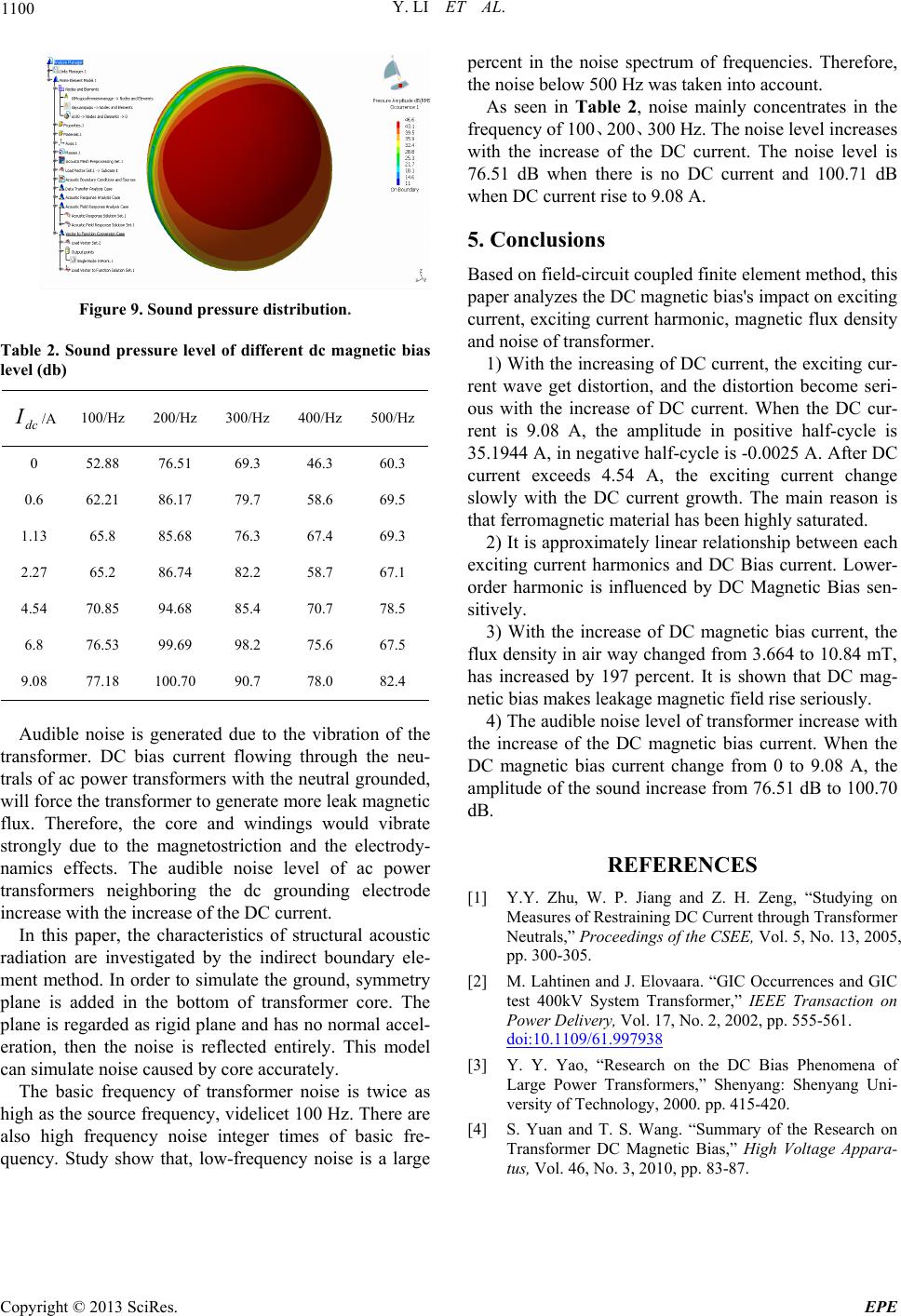
Y. LI ET AL.
Copyright © 2013 SciRes. EPE
1100
Figure 9. Sound pressure distribution.
Table 2. Sound pressure level of different dc magnetic bias
level (db)
dc
I/A 100/Hz 200/Hz 300/Hz 400/Hz 500/Hz
0 52.88 76.51 69.3 46.3 60.3
0.6 62.21 86.17 79.7 58.6 69.5
1.13 65.8 85.68 76.3 67.4 69.3
2.27 65.2 86.74 82.2 58.7 67.1
4.54 70.85 94.68 85.4 70.7 78.5
6.8 76.53 99.69 98.2 75.6 67.5
9.08 77.18 100.70 90.7 78.0 82.4
Audible noise is generated due to the vibration of the
transformer. DC bias current flowing through the neu-
trals of ac power transformers with the neutral grounded,
will force the transformer to generate more leak magnetic
flux. Therefore, the core and windings would vibrate
strongly due to the magnetostriction and the electrody-
namics effects. The audible noise level of ac power
transformers neighboring the dc grounding electrode
increase with the increase of the DC current.
In this paper, the characteristics of structural acoustic
radiation are investigated by the indirect boundary ele-
ment method. In order to simulate the ground, symmetry
plane is added in the bottom of transformer core. The
plane is regarded as rigid plane and has no normal accel-
eration, then the noise is reflected entirely. This model
can simulate noise caused by core accurately.
The basic frequency of transformer noise is twice as
high as the source frequency, videlice t 100 Hz. Ther e are
also high frequency noise integer times of basic fre-
quency. Study show that, low-frequency noise is a large
percent in the noise spectrum of frequencies. Therefore,
the noise be l o w 500 Hz wa s taken into account.
As seen in Table 2, noise mainly concentrates in the
frequency of 100、200、300 Hz. The noise level increases
with the increase of the DC current. The noise level is
76.51 dB when there is no DC current and 100.71 dB
when D C current rise to 9 . 08 A.
5. Conclusions
Based on field-circuit coupled finite element method, this
paper analyzes the DC magnetic bias's impact on ex citin g
current, exciting curren t harmonic, magnetic flux density
and noise of transformer.
1) With the increasing of DC current, the exciting cur-
rent wave get distortion, and the distortion become seri-
ous with the increase of DC current. When the DC cur-
rent is 9.08 A, the amplitude in positive half-cycle is
35.1944 A, in neg ative half-cycle is -0.0025 A. After DC
current exceeds 4.54 A, the exciting current change
slowly with the DC current growth. The main reason is
that ferromagnetic material has been highly saturated.
2) It is approximately linear relationship between each
exciting current harmonics and DC Bias current. Lower-
order harmonic is influenced by DC Magnetic Bias sen-
sitively.
3) With the increase of DC magnetic bias current, the
flux density in air way changed from 3.664 to 10.84 mT,
has increased by 197 percent. It is shown that DC mag-
netic bias makes leakage magnetic field rise seriously.
4) The audible noise level of transformer increase with
the increase of the DC magnetic bias current. When the
DC magnetic bias current change from 0 to 9.08 A, the
amplitude of the sound increase from 76.51 dB to 100.70
dB.
REFERENCES
[1] Y.Y. Zhu, W. P. Jiang and Z. H. Zeng, “Studying on
Measures of Restraining DC Current through Transformer
Neutrals,” Proceedings of the CSEE, Vol. 5, No. 13, 2005,
pp. 300-305.
[2] M. Lahtinen and J. Elovaara. “GIC Occurrences and GIC
test 400kV System Transformer,” IEEE Transaction on
Power Delivery, Vol. 17, No. 2, 2002, pp. 555-561.
doi:10.1109/61.997938
[3] Y. Y. Yao, “Research on the DC Bias Phenomena of
Large Power Transformers,” Shenyang: Shenyang Uni-
versity of Technology, 2000. pp. 415-420.
[4] S. Yuan and T. S. Wang. “Summary of the Research on
Transformer DC Magnetic Bias,” High Voltage Appara-
tus, Vol. 46, No. 3, 2010, pp. 83-87.